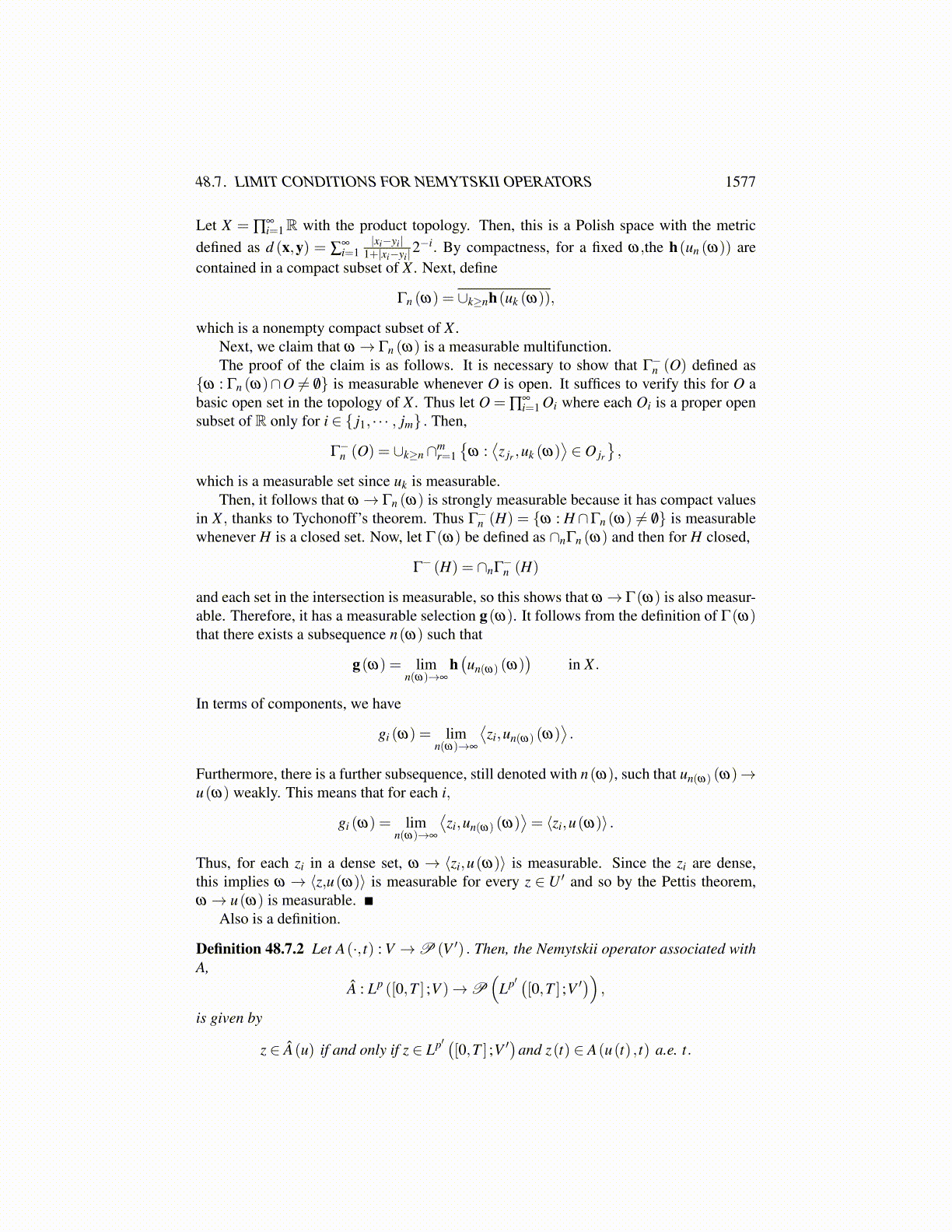
48.6. AN EXAMPLE 1577
That second term on the right converges to 0. It equals(∫GC|ξ (un)−ξ (u)|p
∣∣u,xk
∣∣p +∫G|ξ (un)−ξ (u)|p
∣∣u,xk
∣∣p)1/p
Now on GC,u,xk (x) = 0 a.e. and so the first term in the parentheses is 0. The secondconverges to 0 by the dominated convergence theorem. Then this shows that the secondterm in * converges to 0. The first obviously converges to 0 from the convergence of un,xkto u,xk . Now consider whether ψ (un) ,xk converges to ψ (u) ,xk . Those functions ψ (un) ,xkare bounded in Lp (Ω) from the above description and so if it fails to converge to ψ (u) ,xk inLp a subsequence converges weakly to ζ ̸= ψ (u) ,xk . But then, the above argument showsthat a further subsequence does converge strongly to ψ (u) ,xk contrary to ζ ̸= ψ (u) ,xk .
Now, from the description of the maximum of two functions given above, we obtainthat max(un,k)→max(u,k) in V provided un→ u in V .
Consider k ∈C ([0,T ] ;V ). Let
K (t)≡ {u ∈V : u(x)≥ k (t,x) a.e. x}
This is clearly a convex subset of V. Is it closed and convex? Is t → K (t) a set valuedmeasurable function?
Claim: K (t) is closed and convex.Proof: It is obvious it is convex. Suppose un → u in V,un ∈ K (t). Then there is a
subsequence, still denoted as un such that un (x)→ u(x) a.e. Hence K (t) is closed.Claim: t→ K (t) is a measurable multifunction.Proof: Consider the subset of C ([0,T ] ;V ) defined by
{u ∈C ([0,T ] ;V ) : for a.e. t, u(t,x)≥ k (t,x) a.e. x}
This is a subset of the completely separable set C ([0,T ] ;V ) and so it is also separable.Let {di}∞
i=1 be a dense subset of C ([0,T ] ;V ) . Then let {bi}∞
i=1 be defined by bi (t,x) ≡max(k (t,x) ,di (t,x)). Thus the functions x→ bi (t,x) are each in K (t) because of theabove Lemma. They are also measurable into V because k,di ∈C ([0,T ] ;V ). Is {bi (t, ·)}∞
i=1dense in K (t)? Suppose u ∈ K (t) . Then t → v(t,x)≡ u(x) is in C ([0,T ] ;V ) and so thereis a subsequence denoted by di which converges pointwise to u in C ([0,T ] ;V ). Therefore,we can get a subsequence such that by the above lemma, max(k (t, ·) ,di (t, ·))→ u(·) in V .Thus {bi (t, ·)}∞
i=1 is dense in K (t) and so t→ K (t) is a measurable multifunction.As an example, you could simply take k to be the restriction to Ω× [0,T ] of a smooth
function.This is an example of an obstacle problem in which the obstacle changes in t and there
is no uniqueness even though there exists a measurable solution to the variational inequalityfor each t.
One could also replace σ (u, t) with a graph having a jump as in the second of thetwo operators and get similar results by beginning with the above solutions and then usingLemma 48.2.2, and the arguments used in the second operator to pass to a limit.
The next section is an interesting result on the pseudomonotone condition for Nemytskiioperators defined in this section.